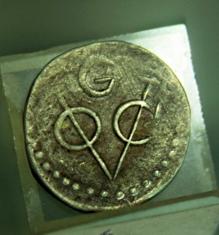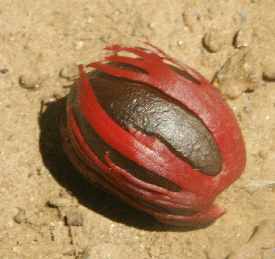
|
|
Ripe nutmeg fruit with visible mace
|

|
|
Nutmeg tree with almost ripe fruits
|
Nutmeg and mace became known in Europe
comparatively late because of the very limited geographical distribution of
the nutmeg tree. Only in the 11.th century it was introduced to European
markets by Arab traders; it was first used chiefly for flavouring beer (see
gale). The spice was thought to originate from India.

|
|
View of Banda Neira from the sea side
|
Although nutmeg was available in Europe since the 13.th century, significant
trade started not before the 16.th century, when Portuguese ships sailed to
India and further, to the famed Spice Islands (Moluccas), today the
Maluku province in Eastern Indonesia.
During the 17.th century, the Dutch succeeded in monopolizing the nutmeg trade,
as they did with cloves. Keeping the monopoly was
easy as the Banda islands, the only place where nutmeg grows naturally, were
so tiny and isolated.

|
|
The Dutch fort Belgica; in the background, the vulcano Gunung Api
|

|
|
View of Banda Neira from the sea side
|

|
|
VOC coin
|
The natives, unwilling to
cooperate with the Dutch colonial regime and its governor Jan Pieterszoon Coen,
were nearly exterminated: Only a few hundred of former 15000 Bandanese survived
the 1621 war and fled to the more Southern Tanimbar archipelago. Arab traders
and Chinese workers came to fill up population, working force was cheap because
of slavery, and thus nutmeg production brought enormous profits despite the
expensive wars. This was simply because the demand for nutmeg in Europe was
constantly high during the whole 17.th century and the Dutch East-India
Company (Vereenigde Oostindische Compagnie, VOC) could
dictate the prices at will. This situation changed only in the 18.th century,
when the French succeeded in smuggling nutmeg trees from the Bandas and
thereby broke the Dutch monopoly.

|
|
Streetlight in Banda Neira: Note the base in the shape of
an upside–down nutmeg fruit.
|

|
|
A monument for clove and nutmeg in the center of Ternate city
|

|
|
VOC coin
|
To any visitor of the beautiful Banda islands, nutmeg’s history is still
present: An ethnically diverse population, a Chinese temple side–to–side to the
mosque, European-style streetlights with their bases shaped like a ripe
nutmeg, beautiful colonial houses now inhabited by locals, a dominating Dutch
fort (benteng belgica) and a city museum showing both greatly
decorated colonial living rooms and paintings of the cruel wars — all these are
witnesses from a time when the Bandas were the center of Dutch power and
interest, and not just a romantic and quiet archipelago, far away from
economical or political importance.
Today, nutmeg’s popularity has shrunken and the spice is less used, still most
in Arab countries, Iran and Northern India, where both nutmeg and mace appear
in delicately-flavoured meat dishes. The Northern Indian spice mixture garam masala (see cumin) also may
contain nutmeg or mace, as well as compositions of Morocco (ras el
hanout, see cubeb pepper), neighbouring Tunisia
(gâlat dagga, see grains of
paradise) and Saudi Arabia (baharat, see paprika).

|
|
Streetlight in Banda Neira: Note the base in the shape of
an upside–down nutmeg fruit.
|

|
|
A monument for clove and nutmeg in the center of Ternate city
|
In Western cuisine, nutmeg and mace are more popular for cakes, crackers and
stewed fruits; nutmeg is sometimes used to flavour cheese (fondue, Béchamel sauce). The combination
of spinach with nutmeg is somewhat a classic, especially for Italian stuffed
noodles, e. g., ravioli. The greatest lovers of nutmeg in
today’s Europe, though, are the
Dutch. They use it for cabbage, potato and other vegetables, but also for meat,
soups, stews and sauces.
Nutmeg is the characteristic flavouring of sauce
Béchamel (white sauce), which despite its French name is today
common to several European cuisines. Wheat flour is dispersed in molten
butter (temperature must be low to prevent browning), hot milk is added
and the mixture is boiled till it thickens; the only spices used are nutmeg and
ground white pepper. Sauce
Béchamel is rarely served at the table, but more often used
for the preparation of baked foods, for on baking it forms a delicious,
golden brown surface, especially if sprinkled with some grated
cheese (e. g., parmigiano).

|
|
Nutmeg tree
|

|
|
Nutmeg seed
|
Lasagna is one of Italy’s most famous dishes: Flat
noodle pasta pieces, stuffing (often meat sauce,
ragù alla Bolognese, but also spinach or other
vegetables) and often cheese are layered in a casserole, topped with a
sauce and baked. Most lasagna recipes prescribe Béchamel sauce, but
some lasagne are actually prepared using a fruity
tomato sauce, particularly the vegetarian versions.
A somewhat similar recipe from Greece is
mousaka [μουσακά],
made from an aromatically spiced ground meat sauce and vegetables, most often
aubergines, also arranged in layers. The sauce used for that recipe is
of Béchamel type, but also contains egg and cheese, which gives a
less liquid texture and a phantastic, flavourful crust after baking.
The classical French spice mixture quatre épices
(meaning four spices
), which goes back to cooking traditions in the baroque
era, contains nutmeg in combination with much white
pepper (some variants use black pepper), cloves
and ginger; further, optional ingredients are allspice and cinnamon. All
components are finely ground together. The resulting powder is mostly used to
flavour meat dishes, especially such which are cooked or braised for a rather
long time, e. g. stews and ragoûts, sometimes also for sausages and pastries. In
character, it is a kind of enhanced
and fortified
pepper; thus, it may be
used whenever black pepper is prescribed, but a
richer and deeper aroma is desired.
Since quite a large fraction of nutmeg is today grown in Grenada, nutmeg has
entered several Caribbean cuisines. In Grenada, it’s omnipresent, the locals
even eating nutmeg-flavoured ice cream (see also
vanilla)! Nutmeg is an optional ingredient in a
famous Caribbean spice paste, Jamaican jerk (see allspice).




























